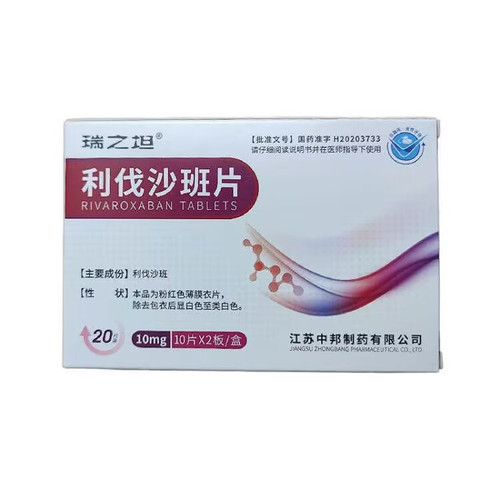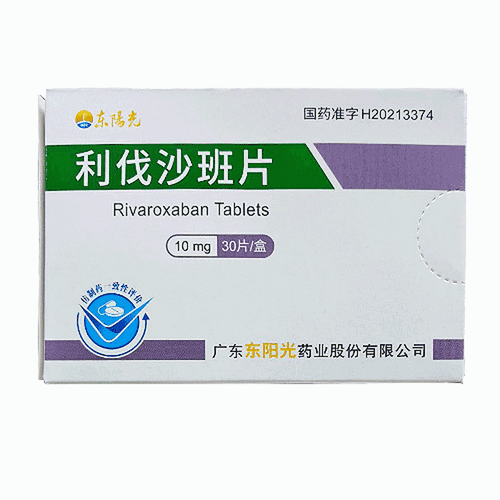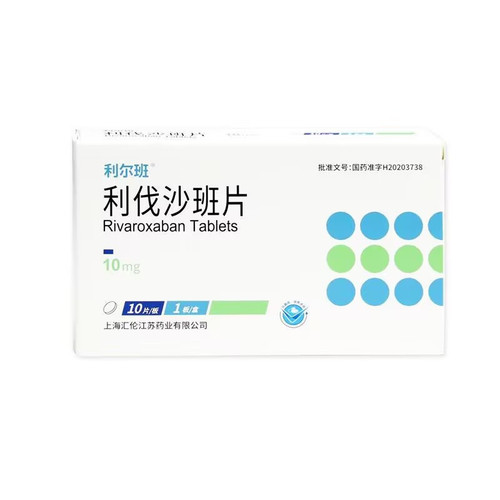Product Overview
[Drug Name]
Generic Name: Rivaroxaban Tablets
Trade Name: Huayituo Rivaroxaban Tablets 10mg x 30 Tablets
[Main Ingredients]
Main ingredient: Rivaroxaban.
[Appearance]
This product is a round, light pink, biconvex coated tablet engraved with "O55" on one side and "S" on the other side.
[Indications/Main Functions]
1. For the prevention of venous thrombosis (VTE) in adult patients undergoing elective hip or knee replacement surgery. 2. For the treatment of venous thrombosis (DVT) in adults to reduce the risk of DVT recurrence and pulmonary embolism (PE) after acute DVT. 3. For the reduction of the risk of stroke and systemic embolism in adult patients with non-valvular atrial fibrillation and one or more risk factors (e.g., congestive heart failure, hypertension, age ≥75 years, diabetes, history of stroke or transient ischemic attack).
[Specifications]
10mg*30 tablets
[Dosage and Administration]
1. The recommended dose is 10mg of rivaroxaban taken orally once daily. If wound bleeding has stopped, the first dose should be taken between 6 and 10 hours after surgery. The duration of treatment depends on each patient's risk of venous thromboembolism, which is determined by the type of orthopedic surgery they undergo. 2. For patients undergoing major hip surgery, a 5-week treatment course is recommended. For patients undergoing major knee surgery, a 2-week treatment course is recommended. If a dose is missed, the patient should immediately take rivaroxaban and continue taking it once daily the following day. Patients can take rivaroxaban with or without meals.
Adverse Reactions: The safety of rivaroxaban 10 mg was evaluated in three Phase 2 studies, involving a total of 4,571 patients undergoing major lower extremity orthopedic surgery (total hip replacement or total knee replacement) who received rivaroxaban for up to 39 days. Approximately 14% of treated patients experienced adverse reactions. Bleeding and anemia occurred in approximately 3.3% and 1% of patients, respectively. Other common adverse reactions included nausea, increased GGT, and elevated transaminases. Adverse reactions should be interpreted in the context of the procedure. Due to its pharmacological mode of action, rivaroxaban may increase the risk of occult or overt bleeding in some tissues or organs, potentially leading to post-hemorrhagic anemia. Signs, symptoms, and severity of bleeding (including potential fatal outcomes) may vary depending on the location, degree, or extent of bleeding. The risk of bleeding may be increased in certain patient populations, such as those with uncontrolled severe arterial hypertension and/or those taking concomitant medications that affect hemostasis. Hemorrhagic complications may manifest as weakness, asthenia, pallor, dizziness, headache, or unexplained swelling. Therefore, the possibility of bleeding should be considered when evaluating patients receiving anticoagulants. Table 1 below lists adverse reactions from three Phase III studies by system organ class (MedDRA) and frequency. Frequency definitions are as follows: Common: ≥1/100 to <1/10. Uncommon: ≥1/1,000 to <1/100. Rare: ≥1/10,000 to <1/1,000. Unknown: No estimate can be made based on available data.
Contraindications
Rivaroxaban is contraindicated in the following patients: 1. Patients with hypersensitivity to rivaroxaban or any of the excipients in the tablets. 2. Patients with clinically significant active bleeding. 3. Patients with liver disease with coagulation abnormalities and a clinically relevant risk of bleeding. 4. Pregnant and lactating women.








